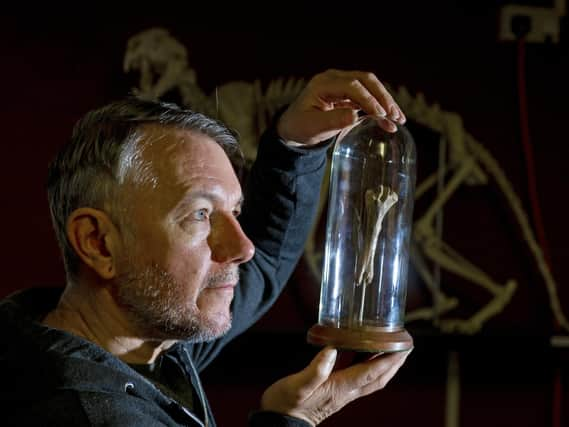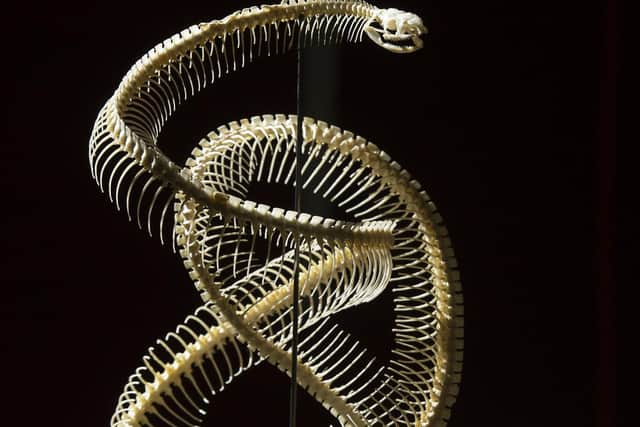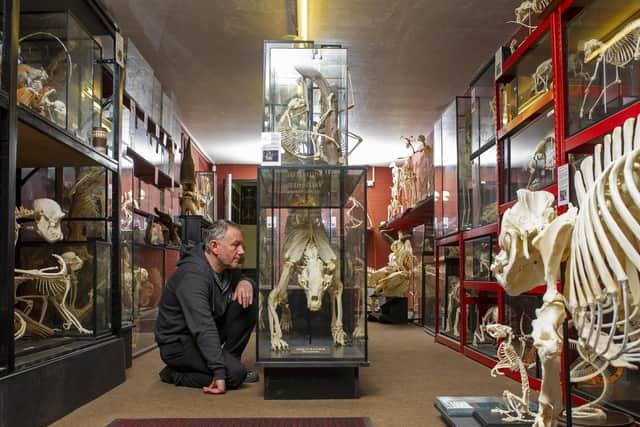Meet the Yorkshire tattooist who created a skeleton museum


These are dotted all around the country and Yorkshire has its fair share of quirky or specialist museums – there’s the Prison and Police museum in Ripon and the splendid Toy Museum in Ilkley, which boasts the finest privately-owned collection of toys, dolls and teddies in the UK.
Another can be found in Dunscroft, on the outskirts of Doncaster. For on an ordinary street, Station Road, stands the Yorkshire Skeleton Museum.
Advertisement
Hide AdAdvertisement
Hide AdHere you will find the bones of all manner of creatures, of every shape and size, from around the world.


Entry is free and it is one of the best collections of its kind in private hands. This is the domain of Alan Turner (he is also an in-demand tattooist). He has been acclaimed by the National Guild of Taxidermists, and his forensic skills are formidable.
You might imagine that Alan has a scientific background, but this isn’t the case. He went to Goole Grammar School and later studied architecture at Hull University.
But rather than making this his vocation, he opted for a more unconventional route and became a professional clown. “Perhaps it was all that larking about at school coming out, but this time, I was actually getting paid for it,” he says.
Advertisement
Hide AdAdvertisement
Hide Ad“There were lots of bookings and it was a lot of fun. I’ve always loved meeting people, and this was the entertainer in me coming out.”


But as the popularity of clowns began to wane and the jobs dwindled he looked for something else. Tattooing came next, and then the skeleton museum.
They may seem unrelated but Alan says there is an interesting link between the two.
“So many artists have drawn or painted skulls in their work. You only have to go to an art gallery anywhere and you see the human skull in so many paintings. Obviously, it’s there as a metaphor for the fact that we each of us only have a certain span of time. But artists also use it as a tool to figure out the structure of the human form. And it appears in so many tattoo designs as well. You cannot avoid it.”
Advertisement
Hide AdAdvertisement
Hide AdWorking as a tattooist led Alan to start thinking about what lies beneath the skin. He began doing research so that he could learn the craft of
skeleton reconstruction and (more recently) of taxidermy, which has, apparently, made something of a return to fashion in recent years, having shed its old-fashioned, and perhaps slightly creepy, image.
It became a hobby that Alan found was increasingly taking up more of his time. Though his enjoyment in the skills of reconstructing a skeleton is not, he readily admits, shared by his wife Tracy, or his daughters Stacey and Abbie, who have told him in no uncertain terms that he is not to bring anything home with him.
“They’ve firmly put their feet down on that one”, he laughs. “They don’t get on with the whole thing really... I’ve tried pointing out that a beautiful sea shell is only another example of a skeleton, but they aren’t having it.”
Advertisement
Hide AdAdvertisement
Hide AdThough the family home is in Goole, Alan opened his tattooing business in South Yorkshire. “I looked around and came up with Dunscroft. I commute to and fro every day and this then became the obvious base for the museum – which suits the family nicely as it means my hobby is kept completely separate.”
He began doing background research online and says his skeletons are all ethically sourced from around the world through trusted contacts.
“Most of the animals I work on are brought in from overseas, in strictly monitored packages and deliveries. European zoos often sell their animals when they die, offering them to the taxidermy community. In the UK, our rules and regulations are very different, the animals have to be buried after death,” he says.
“If you like, what I do is a form of recycling, because an animal which becomes an example of taxidermy will have absolutely no bones at all in it. It is held together by the fur or the skin and will have wire inside it so that it is displayed in a pose. The bones will become a separate part of the displays in the museum.”
Advertisement
Hide AdAdvertisement
Hide AdPiecing together a skeleton again is something of an art form. “I always say that reconstruction is a little bit like Lego – only that there isn’t a book of instructions. It’s part memory, part intuition and part a ‘feel’ for that particular creature. And there are infinite permutations”.
There are now more than 250 skeletons housed in the museum, ranging from simple domestic creatures through to dinosaur bones. There are even insects in the collection, and Alan explains that the “skeleton” of these creatures is similar in many respects to a sea shell.
There are many more examples stored away carefully and Alan admits that he is beginning to run out of space. Every exhibit has an information label, and he is nearly always on hand to offer more information.
The museum is a like a cross between a natural history museum and a curiosity cabinet and has reopened again following the lockdown with opening hours and contact details on its website.
Advertisement
Hide AdAdvertisement
Hide AdAlan says he isn’t geared up for school parties, but is keen to have visitors - though people are advised to contact him in advance.
“I find that people ask a ton of questions. Nearly everyone is really intrigued and, I hope, they all go away a little wiser about the animal world around them.”
So does he have a favourite exhibit? “It’s a giant anteater. Anatomically, all I can say is that it is a weird creature, but when I got it all together it looked fantastic, very sculpture-like.”
From small beginnings, Alan has built up his collection which he believes is among the largest private collections on display in the country.
Advertisement
Hide AdAdvertisement
Hide AdAnd when you ask what the chief requirement in his profession is, he says simply: “It’s a bit like creating a tattoo on someone. You need infinite patience.”
That and an enquiring mind, and no shortage of skill. “I always want to find out the why and the how. What I like with this is that I’m always learning something new. People are sometimes surprised at what I do and what the collection is all about. But I think it’s nice to be a bit unconventional...”
Yorkshire Skeleton Museum, 243 Station Road, Dunscroft, Doncaster DN7 4DY. For contact details and more information about opening hours call 07976 763164 or visit the website https://skeletonmuseum.co.uk/
Support The Yorkshire Post and become a subscriber today.
Your subscription will help us to continue to bring quality news to the people of Yorkshire. In return, you'll see fewer ads on site, get free access to our app and receive exclusive members-only offers.
Advertisement
Hide AdAdvertisement
Hide AdSo, please - if you can - pay for our work. Just £5 per month is the starting point. If you think that which we are trying to achieve is worth more, you can pay us what you think we are worth. By doing so, you will be investing in something that is becoming increasingly rare. Independent journalism that cares less about right and left and more about right and wrong. Journalism you can trust.
Thank you
James Mitchinson
Comment Guidelines
National World encourages reader discussion on our stories. User feedback, insights and back-and-forth exchanges add a rich layer of context to reporting. Please review our Community Guidelines before commenting.